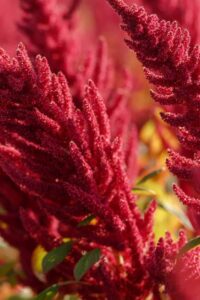
- Dt.inderjit.walia@gmail.com
- +91 89308-32001
Menu
Amaranth (Amaranthus caudatus), often referred to as amaranth millet, is a pseudocereal that has gained recognition in India for its exceptional nutritional value and versatility. While not a true millet, it is commonly grouped with millets due to its similar uses and health benefits. Amaranth has a long history in India, where it was traditionally used in various dishes and even celebrated in festivals.
Amaranth is further classified into two main culinary groups according to vegetable (A. cruentus, A. dubius, and A. tricolor) or grain (A. cruentus, A. caudatus, and A. hypochondriacus) usage. But the history of Amaranth dates back 8000–6000 years where its seed was discovered in archeological sites in Argentina.
In India, amaranth is known by various names such as Rajgira, Ramdana, or Chaulai, and it is valued for its gluten-free properties, high protein content, and rich supply of essential amino acids, fiber, and micronutrients. It is used in a variety of traditional dishes, including flatbreads, porridges, and snacks, showcasing its versatility in Indian cuisine. The cultivation of amaranth in India is not only important for its nutritional benefits but also for its resilience. It can thrive in diverse climatic conditions and requires fewer resources than many other grains, making it a sustainable crop choice for many farmers. As India continues to explore ancient grains as part of a healthy diet, amaranth stands out as a prime example of a traditional food with modern relevance.
Kingdom: Plantae
Order: Caryophyllales
Family: Amrantheaceae
Genus: Amaranth
Species: cruentus

In Eastern India, Jharkhand and Odisha have important cultivation in their tribal belts and mountains regions, with districts like Ranchi, Singhbhum, and Mayurbhanj being major sites. West Bengal also contributes to its cultivation, notably in the rocky districts of Darjeeling and on the plains, which include sections of the Sundarbans. Southern India sees widespread cultivation in Karnataka, particularly in Chitradurga, Tumkur, and Hassan, as well as in Tamil Nadu’s Nilgiris and other Western Ghats regions. Amaranth is grown in Andhra Pradesh and Telangana as well, notably in tribal communities and places with poor soil fertility.
Amaranth’s distribution across India is determined by its adaptability to diverse climatic conditions, ranging from moderate to tropical, and its ability to grow in a variety of soil types, including sandy, loamy, and rocky soils. Traditional agricultural practices and local dietary habits also play an important role in its cultivation patterns.
